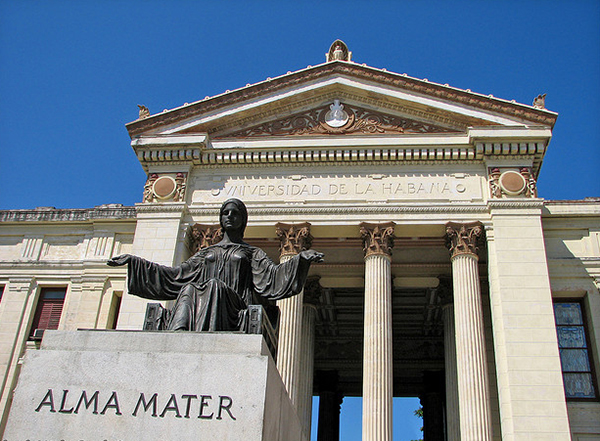| KEY FACTS | |
|---|---|
| Size | 3,515 square miles (9,104 square kilometers) |
| Population | 3,500,000 (76% white, 12% black, 12% mixed and other) |
| Status | Unincorporated territory of the United States |
| Official language(s) | Spanish, English |
| GDP per capita (2018) | $30,586 |
| Currency | US dollar |
| Electricity | US standard two-prong |
| Driving | on the right |
One cannot say they know it all about the Caribbean without ever visiting Puerto Rico. In fact, there is no other place in the world like this US territory where the Spanish and American cultures coexist and thrive. Puerto Rico belonged to Spain for over 300 hundred years until it was ceded to the United States in 1898 after a bloody war between the two countries. Today, Puerto Rico remains as much as Spanish as it is American. The mix of cultures makes Puerto Ricans unique and you will quickly find that they are very proud of their distinctive heritage and identity. Sadly, although Puerto Ricans are American citizens since 1917, they are still not eligible to vote in US presidential and congressional elections. This could be one of the reasons why when hurricanes Irma and Maria devastated the island couple years ago that help was slow from the mainland was slow to reach Puerto Rico.
Despite the extensive damage caused by the 2017 hurricanes to the infrastructure of the island, Puerto Rico has remained resilient and quickly rebuilt from much of the devastation. Nowadays, Puerto Rico as well as its associated islands of Culebra and Vieques are once again popular tourist destinations with a rich offering of attractions, activities and accommodations. Actually, due to its large size (Puerto Rico is the third biggest island in the Caribbean after Hispaniola and Jamaica), varied geography, rich history as well as ease of access, Puerto Rico is one of the most fun places to visit in the Caribbean, especially if you have more than a couple days to spare. To entice you even more, consider that Puerto Rico is home to the only tropical forest within the Unites States (El Yunque) as well as the world’s biggest radio telescope (Arecibo Observatory) and the world’s most famous bioluminescent underwater experience. On top of that. Puerto Rico is constantly ranked in the top three best party scenes in the Caribbean and a couple of its beaches regularly make it to the top ten of the most beautiful in the world. With all the above it mind, it is no wonder that Puerto Rico attracts over 3.5 million tourists every year and this number has been continually growing over the last decade (with exception for 2017 when hurricanes Irma and Maria struck the island).
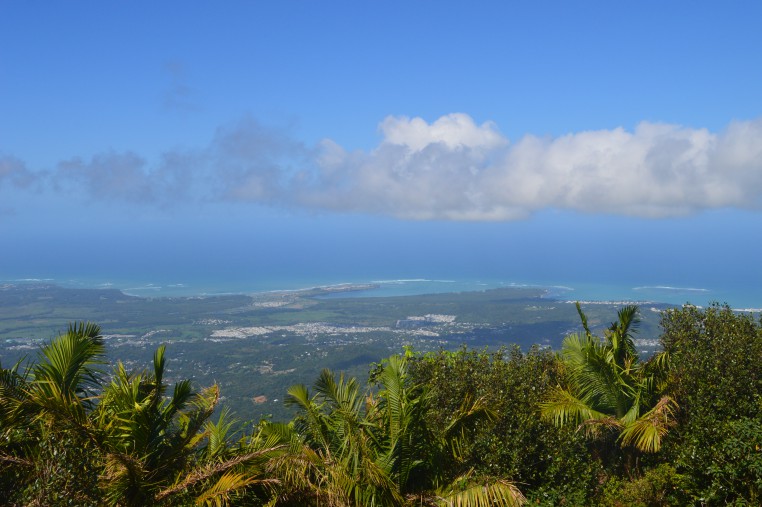
Getting there
Because it is a US territory, Louis Munoz International Airport in San Juan gets direct flights from more US locations than any other airport in the Caribbean. In fact, there are as many as three non-stop flights to Puerto Rico from cities like New York, Chicago and Miami. This means American travellers have it easy to get to the island all year round. Many of them also end up changing here to other Caribbean destinations making Louis Munoz airport a truly international super hub. Canadians can get to Puerto Rico with direct flights from Toronto as well as Montreal whereas European visitors will most likely have to change in the US or on another Caribbean island as there are rarely any non-stop flights to Puerto Rico from Europe (Frankfurt in Germany is your best bet).
Besides getting to Puerto Rico itself, for some visitors, the final destination is either the island of Vieques or Culebra. If that is where you want to get to as well, you have two options. You can take a short, 20 minute flight from San Juan using local airlines (Vieques Air Link or Air Flamenco) or you can drive/get a ride to Ceiba on the eastern coast of Puerto Rico, which takes about 90 minutes and then take a 30 minute ferry to either of the two islands. It’s important to note that the ferry used to operate from Fajardo, but this has changed very recently. Another noteworthy point is that tickets for ferries can only be bought on the day at the ticket booth. This means if you are late and at the end of the line, you may not get on the ferry you intended to take! Finally, keep in mind there are tourist and cargo ferries and only the second ones transport cars. However, it is against policies of local car rental companies to transport their cars on these ferries. Hence, don’t risk it if you don’t have to!
Getting around
Renting a car is a popular way to get around Puerto Rico. Although hurricanes Maria and Irma damaged many of the major roads and highways on the island, Puerto Rico still has a solid network of roads that will get you to all the key corners of it. Knowing Spanish can be helpful and that is the language of road signs. Nonetheless, navigating between the various roads and towns is relatively easy compared to many other Caribbean destinations. If you don’t want to drive, there is always the option of local buses and vans that depart from various city terminals. Keep in mind though that for the drivers of theses buses what is often more important than departing on time is to get them full to capacity. Hence, a trip that you planned for an hour may often take 90 minutes. If you spend most of your time in and around San Juan, you will do just fine using local taxi service and buses. In fact, you can also catch an Uber here and the rates are very reasonable.
Things to explore
A month time is not enough to explore all the amazing attractions of Puerto Rico and its associated islands. There is so much to see and do in San Juan alone that a week here will not be boring nor enough. In fact, the capital city is made up of at least three distinct parts, each one very different from the other and almost feeling like several separate cities. First, there is the historic Old San Juan, which is where the modern history of the island started. Ponce de Leon landed here in 1508 and established the first Spanish settlement. He quickly initiated extensive construction of fortifications including an impressive fortress of El Morro, which is as much as 150 feet tall can be seen from miles away along the coast. You can visit the fortress every day and the cost to see insides of it is only $5. Leading away from El Morro are San Juan city walls called La Fortaleza and if you follow them along the side of Bahia de San Juan bay you will get to Puerta De San Juan, the main entrance to the city during the colonial times. If you walk instead on the other side of the Old city facing the Atlantic, you will reach another impressive fortress built by the Spanish in the 17th century – Castillo San Cristobal. Entrance fee here is also $5 and you can explore this large fort every day of the week.
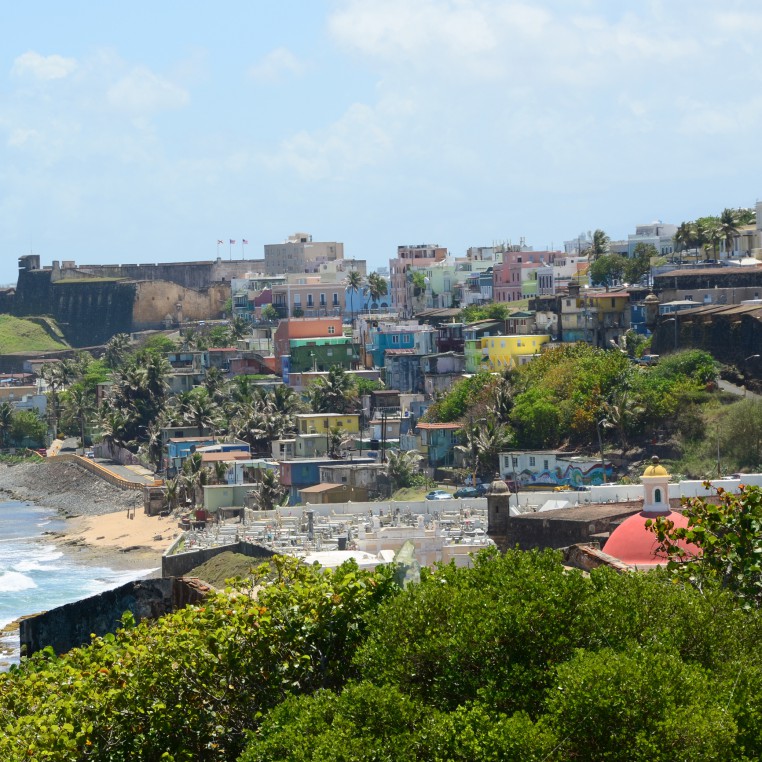
Besides the large and historically significant fortifications, Old San Juan is also known for its beautiful churches, architecture and museums. Places you will definitely want to check out are San Juan Bautista Cathedral and Iglesia San José, two churches considered to be some of the oldest in all of the Western Hemisphere, Museo de las Américas located in old army barracks and showcasing history of the island going all the way back to its original Taino inhabitants as well as Plaza de Armas, which was the city’s main square for many centuries and is now surrounded by lovely and colourful buildings built in a Spanish colonial style. Finally, be sure to take some pictures in front of the large Raíces Fountain at the end of the popular Paseo de la Princesa. The fountain was constructed in 1992 to celebrate the island’s modern history dating back to Columbus’ landing in 1493.
We mentioned three parts of San Juan, but have spent much time describing the riches of Old San Juan. Besides it, there is the area of Condado and Ocean Park located along the coast and populated by hotels and apartment complexes similar to what you find in Miami Beach. This is where the nightlife of Puerto Rico is buzzing the most with many nightclubs and casinos located here, though there isn’t much sightseeing to do here. Finally, there is the area of Greater San Juan, which includes many busy districts south of Old San Juan and Condado and there are lots of really cool things to see here. For example, in the district of Ramon Navarez you will find a beautiful botanical garden called Jardín Botánico de Río Piedras with many stunning examples of local plants, trees and birds. On other hand, in the district of Universidad, you will find the campus of the University of Puerto Rico, which is densely populated with beautiful and historically important buildings. It also has a museum of history, anthropology and art that is free to visit and is open every day of the week. And finally, just across the bay from Old San Juan, the district of Marina Bahia is the home of the very original Bacardi distillery. If you like rum, this is the place in Puerto Rico to explore its various tastes and flavours!
To explore all flavours of Puerto Rico, getting out of San Juan is a must. Cities like Mayagüez on the western coast and Ponce on the southern coast have their own rich history and culture and are surrounded by natural beauty. In the first of these two cities make sure to explore the local zoo that includes a fantastic butterfly park as well as the coastal boardwalk and park stretching for over two miles. In Ponce, on the other hand, be sure to visit the Hacienda Buena Vista coffee plantation, which dates back to the 19th century and has a photogenetic waterwheel as well as Parque de Bombas, an old firehouse converted into a colourful museum, and which is often pictured on postcards from the city. It is worth adding that if you travel between Mayagüez and Ponce, right in the middle between the two lays an extensive nature’s reserve called Bosque Estatal de Guánica. This hilly park has miles of trails in a sub-tropical forest with some of them leading along the coast to impressive wild beaches like Playa Tamarindo, which is a located in a stunning bay with calm waters and rarely has more than a couple human visitors.
Speaking of beaches, the count of them across Puerto Rico, Culebra and Vieques goes into the hundreds! It is no wonder, therefore, that Puerto Rico has several beaches ranked among the world’s most beautiful. Possibly the most famous of them all is Playa Flamenco on Culebra, which has some amazing snorkelling and as an added bonus – rusting American tanks parked on its sands. Other notable beaches to explore include Playa de Piñones and its long boardwalk, which you can explore with rental bikes from the office of Corporacion Piñones Se Integra, Luquillo Beach with very calm waters and easy access from the main highway connecting San Juan and Fajardo, as well as the beach on Isla Caja De Muertos near Ponce where the waters are perfectly still and perfectly turquoise. Finally, if you are into being the only person(s) on a beach, consider staying several days on Vieques. Much of the island is now a national park and there are tens of long sandy beaches that you can get to with a 4×4 car and that you will most likely have all to yourself.
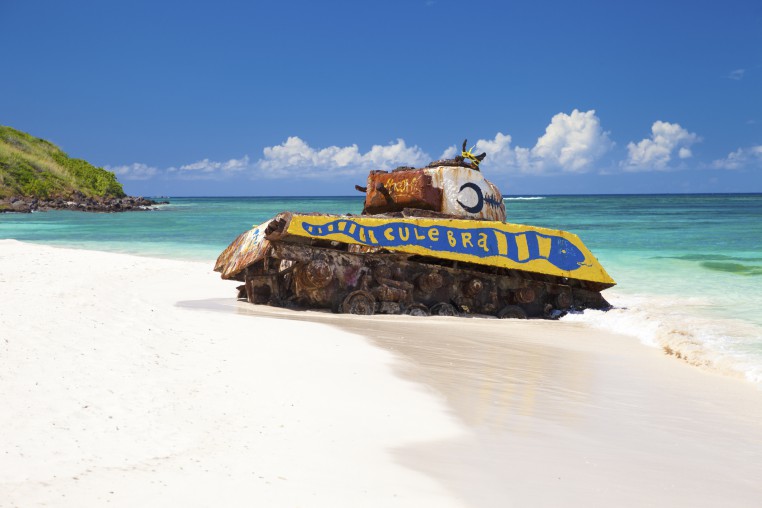
We mentioned in the introduction a couple sights that are truly unique to Puerto Rico. Here is a brief description of these places:
- El Yunque National Forest – rain-forest and national reserve with 13 official trails leading to and through beautiful waterfalls and viewing outposts. There are hundreds of plant and bird species to observe here and there is also a great visitor center with free maps and exhibits. You can get to trails from each cardinal direction and you can park for free along the many winding roads cutting through the forest.
- Arecibo Observatory – the second largest radio telescope in the world is an impressive sight and a fantastic spot for Instagram worthy selfies. The telescope was constructed in 1963 and featured in several Sci-fi movies including the famous blockbuster – “Contact”. The dish of the telescope itself is 1,000 feet across and takes as much as 118 acres of space in the hills of the Arecibo district. It is only an hour drive from San Juan and its located just a couple miles away from another spot worthy of a visit, national park of Bosque Estatal De Río Abajo.
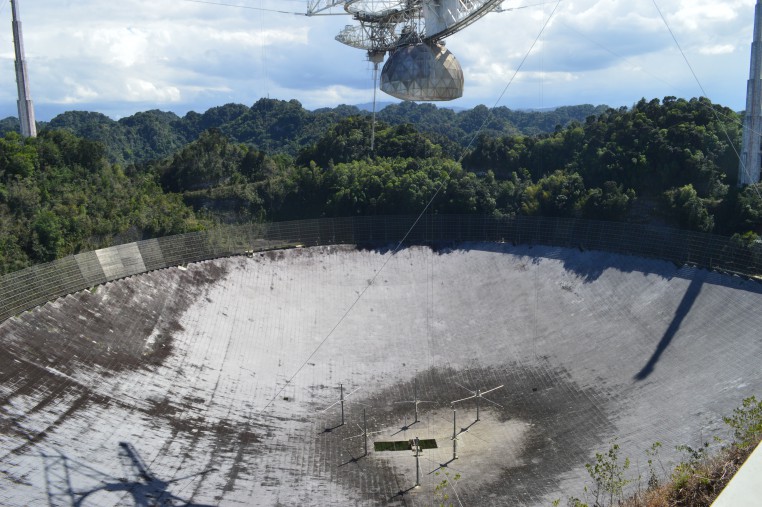
- Bahía Bioluminiscente – also called Mosquito Bay and located on Vieques island, this is where tiny microorganisms called dinoflagellates react to water disturbance and through a chemical reaction turn unsettled water into a vivid blue colour. Many kayaking tours are organized here at night time and the magic of the experience is undisputed!
- Cavernas de Camuy – an extensive system of caves discovered as recently as 1958 and still largely unexplored. So far, 220 caves have been mapped, of which a small, but impressive number is open to the public (though as of February 2019 the caves are still closed to visitors due to damage from 2017 hurricanes). Worth noting that the underground Rio Camuy located here is the third largest such a river in the world.
Accommodations
Despite the fact that Puerto Rico has plenty of great, big and small hotels, the number of places to stay on the island is not as extensive as on other popular Caribbean destinations like the Dominican Republic, Jamaica or even the much smaller St.Lucia. What is more, the 2017 hurricanes of Irma and Maria significantly damaged many of the popular hotels with many of them now closed permanently or still rebuilding. Nonetheless, you are always sure to find a place to stay in Puerto Rico even if your budget is very limited.
Your best bet to find the right fit is, no surprise, the capital of San Juan. For easy access to all important sights and many dining options you will want to stay in Old San Juan where most hotels are located right on busy streets and often take the form of large townhouses. Two interesting options to consider here are Hotel El Convento, which as the same suggests used to be convent as well as CasaBlanca Hotel, which is beautifully decorates and has an amazing rooftop with several bathtubs you can jump into (yes, you read that right!). If you rather be right on the beach than in the city center, than you have many options of bigger hotels in Condado, which is just a 15 minute drive from Old San Juan. There is the Condado Vanderbilt here for those with a bigger wallet, El San Juan Hilton Hotel for those who want to have a night club right at their hotel (Club Brava is here) or Tres Palmas Inn for those who are looking for something more cozy and inexpensive.
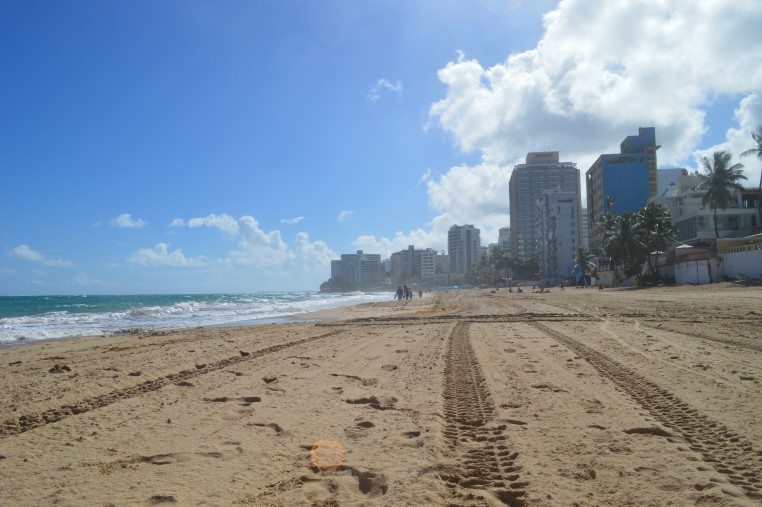
Outside of San Juan, the biggest resorts are located to the east of the city on the northern coast. There is four of them (Gran Melia, Wyndham Grand Rio Mar, St. Regis Bahia and Waldorf Astoria) and each is located right on a beach, has a large golf course, spa and several restaurants. The true differences between them are mainly the quality of personalized service, brand recognition and price. Though the western and southern sides of Puerto Rico do not have resorts like the ones mentioned above, there are still many very cool accommodation options to choose from here. For example, In Guánica you will find a true gem, Compamarina Beach Resort, where you can stay in a beautiful villa surrounded by acres of tropical park and away from signs of civilization. Alternatively, if you don’t mind the city life, in the nearby Ponce you will find the oldest hotel in Puerto Rico, Hotel Melia, where you can get a room for less than $150 per night. And, on the western coast, check out Villa Montana where you can get an inexpensive villa right on a mostly deserted beach.
Finally, it is useful to mention accommodations on Culebra and Vieques as many visitors skip Puerto Rico altogether and fly or ferry directly to stay on one of these two islands. If this is what you want to do or you just want to spent the night while visiting from the mainland, you will have an option to sleep in either, a boutique hotel or a family run B&B. There are many of them spread throughout the islands, though the ones with good reviews sell out quickly in high season. If you can’t get into the hotel you like, consider renting out a whole house or apartment as many local residents offer their homes for such rentals on a weekly basis. Also, make sure to plan your transportation to and from your hotel or apartment ahead of time as cars in general and taxis in particular, are in very limited supply on both islands.
Food & restaurants
The official cuisine of Puerto Rico is comida criolla. In loose translation this means “creole cooking” though the name is unique to Puerto Rico and refers specifically to dishes that come out of the island. The secret to the unique taste of comida criolla dishes lays in the spices that are added to them. These include a paste made of garlic, onion, cilantro and potatoes and peppers called Sofrito, as well as another paste made by mixing turmeric, salt, pepper, oregano, onion and garlic and called Adobo. In all, you can expect to find many items on menus in Puerto Rico to list Sofrito and Adobo and you can also buy them in local stores in case you want to try cooking with them yourself or just taking them home as a gift.
Some of the Puerto Rican dishes you may be tempted to make or will definitely see as an option in lots of restaurants are: mofongo (mashed plantains usually served with meat), pasteles (root vegetable in plantain leaf) and bacalaitos (fritters made from codfish). As you may expect, the highest number of tasty restaurants serving comida criolla as well as dishes of many other regions are located in Greater San Juan with many of the most exclusive ones situated in Old San Juan and Condado. Our two favourite restaurants in San Juan serving Puerto Rican food at reasonable prices are cozy La Fonda del Jibarioto in Old San Juan and a slightly more upscale Oceano in Condado, which has a lovely deck and plenty of outdoor tables overlooking the Atlantic ocean.
Nightlife
Although most cities and towns in Puerto Rico like to party and stay up late, San Juan beats them all by a mile. Although both, Old San Juan and the beachfront area of Condado/Ocean Park, are filled with bars and music clubs, the vibe between the two places could not be more different. The first area is very much about cozy and relaxed bars where locals and tourists alike mix while drinking fancy cocktails and listen to local folk music. The crowd is mixed here, though somewhat older. Many bars close around midnight and it becomes pretty quiet by 2am. On the other hand, Condado is all about loud music clubs, all night dancing and casinos. The crowd here is definitely young and loud here and at 2am everything is still very much buzzing. If you are keen to join the fun, Club Brava and Dubai Lounge are two popular clubs open every Friday and Saturday and often playing a mix of top 40, hip hop and Spanish dance music.
Sports & adventure
Puerto Ricans love sports and they are very good in many of them! The island sends its own team to the Olympics separately from the United States and has had won many medals over the years in sports such as boxing, tennis and track & field. However, the sport that Puerto Ricans are most crazy about and, for which they are most recognized in the Unites States for is baseball. There have been lots of famous baseball players in American Major Baseball League from Puerto Rico such as Roberto Clemente, Yadier Molina or Carlos Beltrán to name just a few. With this in mind, you will not be too surprised to find out that the most common sports facilities in Puerto Rico are baseball stadium and fields.
Interestingly, another sports facilities, of which Puerto Rico has lots and probably more per square mile than any other island in the Caribbean are professional golf courses. We mentioned four resorts earlier with 18-hole golf courses but there are as many as 15 more such courses throughout the island, such as Golf Links at Royal Isabela and TPC Dorado Beach, both of which are often attended by top 100 PGA Tour golfers. If golf is definitely not your thing, how about tennis? Many hotels have their own courts and there are also lots of public courts available throughout the bigger cities.
[embedyt]https://www.youtube.com/watch?v=aSzUW84UIks[/embedyt]Outside of cities, consider that Puerto Rico has as many as 10 zip-lining parks with some of them also offering horseback riding as well as ATV rentals and at least two of them can take you on a zip-lining tours of El Yunque. If you like water parks, you are in luck as well as there are also +10 of them on the island with The Watermill in Dorado being our favourite for its cool design and unique water fun features. If, what we can completely understand, swimming pools are not what you came for to Puerto Rico, than you will be glad to know Puerto Rico has some amazing spots for diving, snorkelling and surfing. There are hundreds of great spots for the first two activities on each of the four cardinal sides of Puerto Rico, though some of the highest reviews for diving go for the coastal waters near La Parguera and its nearby islands. When it comes to surfing, you are sure to meet some expert surfers all year round on the beaches of Rincon, where waves are consistently conducive to board as well as kite and wind surfing.
Safety and security
Puerto Rico isn’t the safest of places in the Caribbean, but it also isn’t one of the most dangerous. San Juan is where you have to be most careful as the city is known for petty theft, harassment, as well as violent crime between local gangs. In fact, it is best if you altogether avoid the districts of La Perla and Caserios, which are especially known for drug trafficking and gang activity. In addition, stay away from local public transport late at night and try not to hang around the city by yourself after dark. Outside of the capital, things are definitely better, but precaution is still advised. If you drive a rental, never leave your valuable belongings in the car and do not carry a lot of money on you if you can help it. Wherever you have an option of paid and guarded parking, take it. Finally, if you plan on hiking or cycling into the countryside, its better if you can organize or join a larger group instead of going in just one or two people. However, do not let the above warnings scare you too much. Despite their economic struggles, Puerto Ricans are very friendly and welcoming and the country is generally pretty safe as serious crime against tourists and visitors is still very rare.
Sightseeing After Dark
While the Caribbean is known for crystal blue waters, white sandy beaches, and afternoon cocktails,…
What are the Top 5 universities in the Caribbean?
Imagine going to a classroom in the morning and then going to a stunning beach…
10 Hollywood movies filmed in the Caribbean
For many of us, choosing a vacation destination involves careful research and taking into consideration…
Is the Caribbean a country? No!
I was surprised to find the question “Is the Caribbean a country?” to be a…
El Yunque, a world of wonders
In the ancient Greek mythology, Zeus was the God of all Gods, who kept a…


